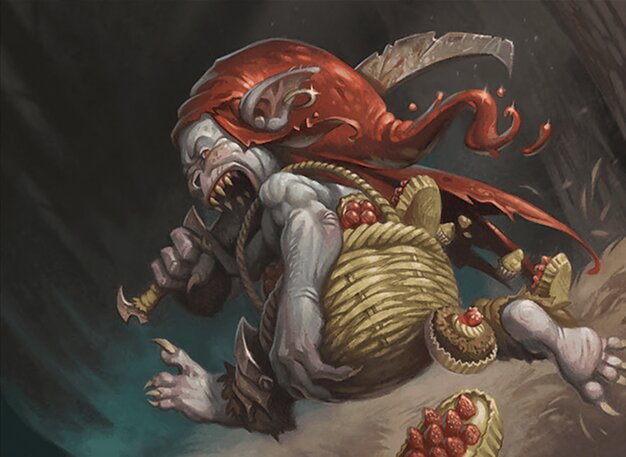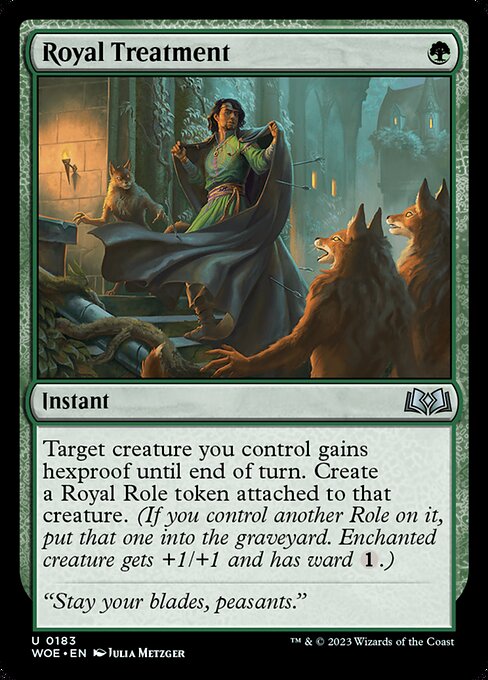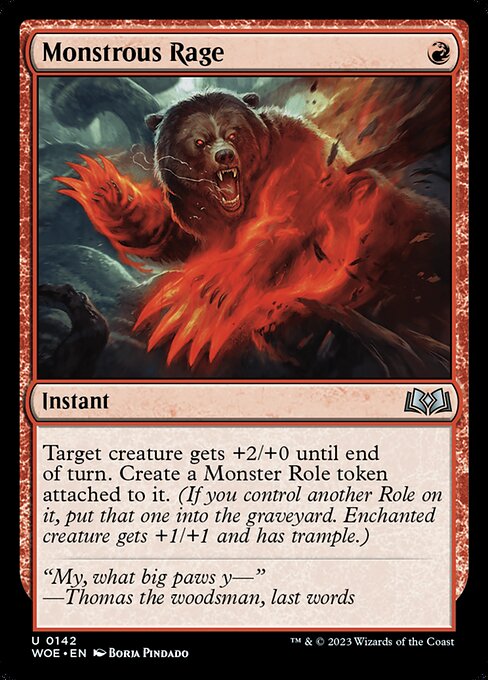Table of Contents
When you think of Aggro in Standard, you immediately come across Soldiers, Mono White, or Mono Red. While these strategies have had a lot of success, there are plenty of new possibilities lurking beneath the surface!
Today, I want to show you my personal favourite aggressive strategy in Standard with which I’ve killed on turn three multiple times. Yes, turn three – in Standard!
If you’ve ever played Infect in older formats, you’ll feel right at home with Gruul Aggro.
Let’s dive in!
Deck Tech



Creatures (16)
Sorceries (4)
Lands (21)
60 Cards
$83.06
Sideboard
15 Cards
$27.73
Creatures
It’s such a weird feeling when Monastery Swiftspear might *not* be the best creature in an aggro deck – but that’s saying a lot about the power level of the other threats. Still, Swifspear is a great turn one threat that quickly demands an answer. It grows incidentally, even when no pump spells are played on it. In fact, you’ll happily keep pumping other creatures since Swiftspear gets that little buff anyways and you don’t want to put all the eggs in one basket.
Swiftspear allows you to have super powerful nut draws that include sequences like turn one Swifty into turn two Swifty plus a pump spell. When done on the play, it’s really hard to stop.
You can also set up kills out of nowhere when your board is clear, the opponent taps out thinking they are safe and you play Swiftspear with a flurry of pump spells.
While the text suggests you should play it in a counters deck and proliferate, it does a completely different job here.
It’s a one-mana 1/1 that dies to anything and is blocked by anything. Why would it be any good?
The trick is that you have a ton of pump spells in the deck, making it much bigger and heavily discouraging the opponent from removing it from the board. An early Audacity already allows it to Lightning Bolt anything upon death.
In some scenario, it also gives you double the damage. You deal combat damage first and then you can sacrifice it to shoot the opponent to deal even more damage. With a 10-power Scamp, that’d be a one-shot kill.
When the opponent is very low on life, any Scamp played is super threatening as they can’t allow it to die even though they’d really want it gone.
Picnic Ruiner is the best uncommon I have seen in constructed in a long time. This card gives you a ton of turn 3 kill potential.
In order to achieve such a kill, Ruiner has to trigger and have 10 power, assuming no previous life loss. A lot of card combinations get us there.
- Double Giant Growth + Audacity,
- Monstrous Rage + Giant Growth + Audacity,
- +1/+1 counter from turn-one Kumano Faces Kakkazan + Monstrous Rage + Giant Growth + anything (like Monastery Swiftspear)
In certain matchups, you will run it out, knowing it cannot die. However, against black-based decks it’s a risk you might not want to take. Depending on the situation, you can make them have it and punish them if you don’t. On the flipside though, you might want to take it slow, and play it only with a couple of protection spells as backup. You really need to assess it well to give yourself the highest chance of winning – not necessarily on turn three.
The adventure part comes up pretty rarely but it might. It will be useful in games where resources matter a lot. Then, you want to take full advantage of every single additional effect you can. Between Ruiner, Questing Druid, and cantripping pump spells, you actually have a lot of staying power.
All in all, this two-mana 2/2 hits like a truck. It’s your key piece to kill in one combat and you need to treat it as such.
Questing Druid has been trying to find a home in Standard, despite the fact that it’s very much playable in high power formats like Modern and even Legacy. Finally, Gruul Aggro has welcomed it into the fold.
Druid has a two-fold role in this strategy. The first is quite obvious – a turn two play that scales with every spell we play. It keeps growing so it demands an answer immediately. You may have noticed a pattern, as the ‘needs to be killed on sight’ motif permeates the whole threat base.
The real value is in its adventure. While Ruiner is predominantly a creature, Druid is here to be sent on an escapade. It shines in spots where the opponent is clearly holding up removal and we can just pass the turn, wasting their mana. Then, on their end step we Seek the Beast, get 2 fresh cards and continue playing. It allows us to play through opposing interaction, generate card advantage, and make the timing uncomfortable for the opponent.
Later in the game, Druid will happily come off the exile zone and join your troops at which point it demands an answer yet again.
I have seen builds without Druid but they are very Best-of-One focused where you go all-in every single game. Druid gives you a ton of counterplay which I’ve found much more successful in the long run.
Spells
This deck plays like an Infect/Heroic shell where you need to leverage your spells wisely. They will act as damage pump, protection, combat trick – all depending on the situation.
This is our only pure protection spell. When played in response to hard removal like Go for the Throat, it stops interaction no questions asked.
It gives us a huge sense of safety, as we can answer opposing removal in the most efficient way – just for one mana. It’s also very difficult to play around from the opponent’s perspective. They need to catch you off green mana or brute force their way through it.
On top of that, Royal role provides constant long-term mini-protection that makes it that much more annoying for the opponent and makes their spells more clunky. Having to pay three mana for Go for the Throat or five mana to exile a creature with The Wandering Emperoris a huge tempo win for us.
This doesn’t get any cleaner than this. +3/+3 instant speed to a creature is a simple yet effective part of the strategy.
The main upside is enabling Picnic Ruiner all by itself, making it a 4/4.
Multiple copies also nicely compound, offering a powerful punch that’s relevant in combat when opponents try to multi block.
I could see going lower on the number of Growths but they have truly overperformed for me. Their presence increases the likelihood of turn three wins immensely.
In a way – a spin on Giant Growth. It will provide +3/+2 and crucially – trample. The difference between trampling and not is unreal. The fact that an opposing 1/1 creature (like Lunarch Veteran) could just chump block your 10/10 threat is embarrassing – and Rage prevents that from taking place.
There is a single downside – they don’t compound well with subsequent copies. You do get the +2/+0 buff but Monster role stays.
The best usage for multiple Rages is to use them on different creatures, granting both trample.
One very cool trick is to allow the opponent to declare blocks and only then grant trample, making the opponent take unaccounted-for damage.
This is the Rancor of our times. Instead of going back to hand, it gives you a fresh card when the enchanted creature is destroyed. It also provides trample whose significance I emphasised in the previous section.
Audacity feels like the safest way to pump a creature since you don’t care *that* much if it dies later – you get a card back after all.
If you suit up a creature with multiple Audacities and it dies, the outcome is beneficial to us. We do get to draw as many cards as we had Audacities.
Ancestral Anger is yet another way to grant trample. The pattern is pretty clear – we need that keyword desperately. It also replaces itself making it a ‘free’ pump in a way.
Thanks to the draw, it makes it much easier to chain spells and almost kill out of nowhere. You could untap with Picnic Ruiner, play a single Anger and draw into, say, Anger into Giant Growth. While unlikely, in a big enough sample you will have these spots.
Anger scales with the number of previously played copies so when adjusting the deck to your preferences, do not go below 4 copies.
Red staple that will continue to show up in aggro decks for as long as it’s legal.
The first gives a nice damage ping but the two other modes are way more relevant. Getting a counter on a turn two creature is huge, as it gets you that much closer to enabling Picnic Ruiner and its 4-power threshold. It can also make a creature un-Cut Down-able right from the start.
The last chapter gives us a hasty 2/2 threat that lets us go a bit wider and spread attackers. If we’ve drawn a lot of pump spells, we can use them on more than one creature, playing around a piece of unconditional removal.
Best of One



Creatures (16)
Sorceries (4)
Lands (21)
60 Cards
$84.08
The Best of One version is similar to Best of Three but is more focused on removal rather than protection.
Budget



Creatures (16)
Sorceries (4)
60 Cards
$45
This shell can actually be budget-ified pretty easily. The biggest miss is the mana base that can hardly support green and red spells at the same time. If you have extra wild cards, spend them on the manabase first.
Matchups and Sideboard Guide
Mirror
| In | Out |
|---|---|
| +4 Witchstalker Frenzy | -4 Giant Growth |
In the mirror, I keep in all the cantripping pump spells and Monstrous Rage for trample. I cut Giant Growth as it does nothing except for giving stats.
I opt to side in four copies of removal and become much more interactive. I expect my opponent to do the same so I keep Royal Treatment. If I see that my opponent does not run removal anyways, I will swap it with Giant Growth.
A good rule of thumb is that you want as aggressive a draw possible on the play and be more defensive on the draw.
Five-Color Ramp
| In | Out |
|---|---|
| +4 Urabrask's Forge | -4 Giant Growth |
Here we want to put the pedal to the metal and take advantage of the fact that Ramp is a very slow deck that does not do much in the early turns. You have to always see whether their mana allows them to play Leyline Binding and whether it costs 1, 2, or 3. You also need to take Virtue of Persistence into account – thankfully it can be countered with a pump spell.
Urabrask's Forge gives us another angle of attack which forces the opponent to adapt. It’s also good in the face of Sunfall against which we don’t have many tools. You can sandbag Monastery Swiftspear and unleash it with a flurry of spells after Sunfall comes down.
Overall we will beat every single slow draw and can play through those more interactive ones.
Mono Red Aggro
| In | Out |
|---|---|
| +4 Witchstalker Frenzy | -4 Ancestral Anger |
Red aggro vs Red aggro. The biggest difference is that we can out-race them with pump spells but we also have more staying power. We will lose the games on the draw where they have a perfect curve and evasion in Phoenix Chick or Goddric, Cloaked Reveler.
Remember that your pump spells will counter any removal they play so we’re overall happy if they target burn at our creatures and not the face – especially in combat. We can also take profitable blocks thanks to our creature sizing.
If you see that the opponent becomes super interactive, you can take a step back and lean more into the adventures in the deck.
Esper Midrange
| In | Out |
|---|---|
| +4 Lithomantic Barrage | -4 Giant Growth |
| +4 Urabrask's Forge | -4 Monstrous Rage |
A pretty interesting matchup where the opponent has both creatures and interaction. Deep-Cavern Bat will take your spells forever most of the time so you do want to make the opponent feel like they have to block.
I switch out 8 pump spells for 4 removal spells and 4 Forges. You don’t want a situation where they run away with the game alongside Raffine, Scheming Seer.
Take your time, play it slow, take advantage of your mana efficiency.
Rakdos Discover
| In | Out |
|---|---|
| +4 Witchstalker Frenzy | -4 Giant Growth |
| +4 Urabrask's Forge | -4 Monstrous Rage |
Similar to Esper Midrange but here there are no counterspells but there are way more creatures. Strategy is largely the same though – we want to be patient and outplay the opponent with our tricks.
If they ever tap out for, say, Geological Appraiser into a creature – this is our moment to shine and force bad blocks. Even if you don’t have pump spells, you can posture as if you did. If you are *really* confident, you can make bluff attacks without pump spells, predicting that the opponent wouldn’t block anyways in the face of a *possible* pump spell.
They do have deathtouch creatures but it won’t matter if you can trample over and deal enough damage to their face. While you don’t want to rush it, you shouldn’t try to grind too much either.
Tips and Tricks
- You can only have one role at a time so if you play Monstrous Rage and then Royal Treatment, you’ll lose trample.
- If you play Seek the Beast from Questing Druid on your main phase, you won’t be able to play the spells on your end step due to the card’s wording.
- If you find Questing Druid off Seek the Beast, you can Seek off that Druid as well. In other words, you can play the adventure part of an exiled card.
- While we get used to Questing Druid growing continuously, remember that it won’t trigger upon green spells.
- If the opponent kills the creature in response to Audacity, you won’t draw a card.
- If the opponent kills the creature in response to Ancestral Anger, you won’t draw a card.
- You will want to sequence your early plays so that on turn two you can deploy a creature with a counter off Kumano.
- You can turn your pump spells into burn spells by playing them onto Cacophony Scamp which is to die. For instance, in response to the opposing Go for the Throat you can play double Giant Growth to shoot the opponent for 7.
- Picnic Ruiner does not care which creature has 4 power or greater – it can be itself but does not have to.
- When you have multiple pump spells, you can play the first one to make sure you trigger Ruiner and keep the rest until blockers are declared. You don’t need to play all of them at the same time.
- Remember that your pump spells can counter conditional removal like Elspeth's Smite, Cut Down, or Play with Fire.
- With multiple Royal Treatments, remember that you will always have the same role but playing another Treatment will grant hexproof that hard counters anything that’s targeting your creature.
- When Cacophony Scamp dies, you can proliferate counters on Questing Druid, Kumano Faces Kakkazan, or the +1/+1 counter off the second chapter of Kumano.
- Against some decks, you might want to proliferate their Saga forcing them to skip a chapter or -1/-1 counters on opposing threats.
Premium >
Enjoy our content? Wish to support our work? Join our Premium community, get access to exclusive content, remove all advertisements, and more!
- No ads: Browse the entire website ad-free, both display and video.
- Exclusive Content: Instant access to all exclusive articles only for Premium members, at your fingertips.
- Support: All your contributions get directly reinvested into the website to increase your viewing experience!
- Discord: Join our Discord server, claim your Premium role and gain access to exclusive channels where you can learn in real time!
- Special offer: For a limited time, use coupon code L95WR9JOWV to get 50% off the Annual plan!


















































